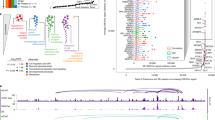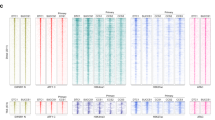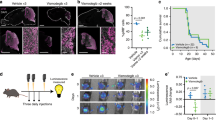Abstract
Neuroblastoma and other pediatric tumors show a paucity of gene mutations, which has sparked an interest in their epigenetic regulation. Several tumor types include phenotypically divergent cells, resembling cells from different lineage development stages1,2,3,4. It has been proposed that super-enhancer-associated transcription factor (TF) networks underlie lineage identity5,6, but the role of these enhancers in intratumoral heterogeneity is unknown. Here we show that most neuroblastomas include two types of tumor cells with divergent gene expression profiles. Undifferentiated mesenchymal cells and committed adrenergic cells can interconvert and resemble cells from different lineage differentiation stages. ChIP–seq analysis of isogenic pairs of mesenchymal and adrenergic cells identified a distinct super-enhancer landscape and super-enhancer-associated TF network for each cell type. Expression of the mesenchymal TF PRRX1 could reprogram the super-enhancer and mRNA landscapes of adrenergic cells toward a mesenchymal state. Mesenchymal cells were more chemoresistant in vitro and were enriched in post-therapy and relapse tumors. Two super-enhancer-associated TF networks, which probably mediate lineage control in normal development, thus dominate epigenetic control of neuroblastoma and shape intratumoral heterogeneity.
This is a preview of subscription content, access via your institution
Access options
Access Nature and 54 other Nature Portfolio journals
Get Nature+, our best-value online-access subscription
$29.99 / 30 days
cancel any time
Subscribe to this journal
Receive 12 print issues and online access
$209.00 per year
only $17.42 per issue
Buy this article
- Purchase on Springer Link
- Instant access to full article PDF
Prices may be subject to local taxes which are calculated during checkout





Similar content being viewed by others
References
Tirosh, I. et al. Dissecting the multicellular ecosystem of metastatic melanoma by single-cell RNA-seq. Science 352, 189–196 (2016).
Tirosh, I. et al. Single-cell RNA-seq supports a developmental hierarchy in human oligodendroglioma. Nature 539, 309–313 (2016).
Patel, A.P. et al. Single-cell RNA-seq highlights intratumoral heterogeneity in primary glioblastoma. Science 344, 1396–1401 (2014).
Suvà, M.L. et al. Reconstructing and reprogramming the tumor-propagating potential of glioblastoma stem-like cells. Cell 157, 580–594 (2014).
Whyte, W.A. et al. Master transcription factors and mediator establish super-enhancers at key cell identity genes. Cell 153, 307–319 (2013).
Hnisz, D. et al. Super-enhancers in the control of cell identity and disease. Cell 155, 934–947 (2013).
Ross, R.A., Spengler, B.A. & Biedler, J.L. Coordinate morphological and biochemical interconversion of human neuroblastoma cells. J. Natl. Cancer Inst. 71, 741–747 (1983).
Singh, S.K. et al. Identification of human brain tumour initiating cells. Nature 432, 396–401 (2004).
Ricci-Vitiani, L. et al. Identification and expansion of human colon-cancer-initiating cells. Nature 445, 111–115 (2007).
Zhu, L. et al. Multi-organ mapping of cancer risk. Cell 166, 1132–1146.e7 (2016).
Bate-Eya, L.T. et al. Newly-derived neuroblastoma cell lines propagated in serum-free media recapitulate the genotype and phenotype of primary neuroblastoma tumours. Eur. J. Cancer 50, 628–637 (2014).
Molenaar, J.J. et al. Sequencing of neuroblastoma identifies chromothripsis and defects in neuritogenesis genes. Nature 483, 589–593 (2012).
Zwiller, J., Treska-Ciesielski, J., Mack, G. & Mandel, P. Uptake of noradrenaline by an adrenergic clone of neuroblastoma cells. Nature 254, 443–444 (1975).
de Pontual, L. et al. Epistasis between RET and BBS mutations modulates enteric innervation and causes syndromic Hirschsprung disease. Proc. Natl. Acad. Sci. USA 106, 13921–13926 (2009).
Young, R.A. Control of the embryonic stem cell state. Cell 144, 940–954 (2011).
Rada-Iglesias, A. et al. Epigenomic annotation of enhancers predicts transcriptional regulators of human neural crest. Cell Stem Cell 11, 633–648 (2012).
Andersson, R. et al. An atlas of active enhancers across human cell types and tissues. Nature 507, 455–461 (2014).
van Limpt, V.A. et al. High delta-like 1 expression in a subset of neuroblastoma cell lines corresponds to a differentiated chromaffin cell type. Int. J. Cancer 105, 61–69 (2003).
Oldridge, D.A. et al. Genetic predisposition to neuroblastoma mediated by a LMO1 super-enhancer polymorphism. Nature 528, 418–421 (2015).
Takahashi, K. & Yamanaka, S. Induction of pluripotent stem cells from mouse embryonic and adult fibroblast cultures by defined factors. Cell 126, 663–676 (2006).
Ocaña, O.H. et al. Metastatic colonization requires the repression of the epithelial-mesenchymal transition inducer Prrx1. Cancer Cell 22, 709–724 (2012).
SEQC/MAQC-III Consortium. A comprehensive assessment of RNA-seq accuracy, reproducibility and information content by the Sequencing Quality Control Consortium. Nat. Biotechnol. 32, 903–914 (2014).
Arumugam, T. et al. Epithelial to mesenchymal transition contributes to drug resistance in pancreatic cancer. Cancer Res. 69, 5820–5828 (2009).
van Nes, J. et al. A NOTCH3 transcriptional module induces cell motility in neuroblastoma. Clin. Cancer Res. 19, 3485–3494 (2013).
Bunt, J. et al. Joint binding of OTX2 and MYC in promotor regions is associated with high gene expression in medulloblastoma. PLoS One 6, e26058 (2011).
Song, Q. & Smith, A.D. Identifying dispersed epigenomic domains from ChIP-Seq data. Bioinformatics 27, 870–871 (2011).
Kennedy, R.E., Archer, K.J. & Miles, M.F. Empirical validation of the S-Score algorithm in the analysis of gene expression data. BMC Bioinformatics 7, 154 (2006).
van der Loos, C.M. Multiple immunoenzyme staining: methods and visualizations for the observation with spectral imaging. J. Histochem. Cytochem. 56, 313–328 (2008).
Cong, L. et al. Multiplex genome engineering using CRISPR/Cas systems. Science 339, 819–823 (2013).
Sanjana, N.E., Shalem, O. & Zhang, F. Improved vectors and genome-wide libraries for CRISPR screening. Nat. Methods 11, 783–784 (2014).
Acknowledgements
This research was supported by grants from KiKa (projects 11, 33, 66), the Dutch Cancer Society KWF (UVA 2010-4878), the Tom Voûte Fund/KiKa, Villa Joep and the European Research Council (ERC-Adv no. 340735). We are indebted to Chris van der Loos, who sadly passed away, for sharing expertise on immunohistochemistry.
Author information
Authors and Affiliations
Contributions
T.v.G., J.K., L.J.V., J.v.N. and R. Versteeg conceived the study, analyzed the data and wrote the manuscript. D.A.Z., P.M. and R. Volckmann performed bioinformatics analyses. N.A., N.E.H., M.B., F.H., N.E.N., M.C.L., A.C., A.L., P.G.v.S. and M.E.E. performed part of the experiments and analyses. J.B. and C.J.M.v.N. performed histopathological analyses of tumor samples. A.J. and A.H.v.K. assisted with data analysis. L.K. and F.B. performed library preparation and sequencing, and L.v.D.-K. and M.H.-S. performed sequencing. E.M.W., M.H., J.J.M. and B.A.W. supervised part of the study. G.A.T. analyzed clinical data.
Corresponding authors
Ethics declarations
Competing interests
The authors declare no competing financial interests.
Integrated supplementary information
Supplementary Figure 1 Phenotypic characterization of MES- and ADRN-type cells.
(a) Bright-field images showing cellular morphology of MES-type (691-MES, 700-MES, 717-MES) and ADRN-type (691-ADRN, 700-ADRN, 717-ADRN) cell lines. Note attached growth of MES-type lines, while ADRN-type cell lines grow as semiattached spheres. Scale bar, 100 μm. (b) PROM1 (encoding the CD133 antigen) mRNA expression in the three MES and ADRN cell line pairs shown in a. (c) FACS analysis of CD133 expression on the isogenic cell lines 691-MES and 691-ADRN. (d) Box plots showing frequency of CD133+ cells in three MES and ADRN cell line pairs as measured by FACS. Each circle represents an individual FACS analysis. (e) Box plots showing motility of MES or ADRN cells as measured in Transwell migration assays. Each circle represents the average number of migrated cells from quadruplicate experiments. (f) Unsupervised cluster analysis (Spearman rank correlation) of the 1,000 genes with the highest standard deviation in the four isogenic pairs of MES and ADRN cell lines. Four MES cell lines cluster on the left, and four ADRN cell lines cluster on the right. The same results were obtained for the 500 or 1,500 genes with the highest standard deviation. (g) k-means clustering for the 1,000 genes with the highest standard deviation in the series of 33 neuroblastoma cell lines mapped in Figure 1c. The 500 or 1,500 genes with the highest standard deviation gave similar results.
Supplementary Figure 2 Spontaneous in vitro interconversion and in vivo tumorigenicity of MES and ADRN cells.
(a) Frequency of CD133+ cells in clones grown from FACS-sorted CD133– AMC700B cells. (b) Survival of mice xenografted with FACS-sorted CD133+ or CD133– cells of cell line AMC700B. Mice were sacrificed when tumors were up to 1 cm in diameter. (c) IHC analysis of the tumors grown from xenografted CD133+ or CD133– 700B cells. Tumors were stained for dopamine β-hydroxylase (DBH) and vimentin (VIM). HE, hematoxylin and eosin staining.
Supplementary Figure 3 Examples of H3K27ac profiles of MES- and ADRN-specific super-enhancer-associated genes.
(a) Five MES-specific genes with associated super-enhancers (SEs). (b) Box plots showing expression of the genes shown in a in the MES and ADRN counterparts of the four isogenic cell line pairs. (c) Five ADRN-specific genes associated with super-enhancers. (d) Box plots showing expression of the genes shown in c in the MES and ADRN counterparts of the four isogenic cell line pairs. Whiskers in b and d denote the interval within 1.5 times the interquartile range (IQR) of the median.
Supplementary Figure 4 mRNA expression levels and super-enhancer status of all TFs in pairs of MES and ADRN cell lines of isogenic origin.
(a–d) XY plots showing the expression of all TFs. TFs with MES-specific expression identified in the MES-specific signature are indicated in orange. TFs with ADRN-specific expression identified in the ADRN-specific signature are indicated in blue. TFs of the signature associated with super-enhancers are indicated by a bold colored dot. (a) 691-MES and 691-ADRN cells. (b) 717-MES and 717-ADRN cells. (c) 700-MES and 700-ADRN cells. (d) SH-EP2 and SH-SY5Y cells.
Supplementary Figure 5 GATA3 binds to the epicenters of super-enhancers of ADRN-specific TFs.
(a) The most prominent GATA3 binding peak19 within super-enhancers of ADRN super-enhancer-associated TFs was used to center a ±1-Mb region. Data are from cell line SH-SY5Y. Gene bodies within the region are indicated in thin stripes, and signature TFs are indicated with thick stripes. The blue dot indicates GATA3, zoomed in c. (b) The same regions are shown, now showing the H3K27ac signal19. (c) Example of the GATA3 and H3K27ac profiles in the region of the GATA3 gene and its associated super-enhancers. The zoomed region shows that GATA3 peaks binds to the epicenter of the H3K27ac domains.
Supplementary Figure 6 H3K27ac profiles of nine cell lines for PHOX2A and PHOX2B.
(a) PHOX2A. (b) PHOX2B. Horizontal blue bars indicate super-enhancer (SE) regions.
Supplementary Figure 7 PRRX1 induces adrenergic-to-mesenchymal reprogramming.
(a) Protein blot analysis of neuroblastoma cell lines 691-ADRN, SH-SY5Y and SK-N-BE(2C) with doxycycline-inducible expression of PRRX1 (t = 96 h). Immunoblots were analyzed for PRRX1 induction, mesenchymal marker SNAI2 and adrenergic markers PHOX2B and DBH. β-actin is used as a loading control. Dox, doxycycline. (b) PRRX1 induces the migratory potential of 691-ADRN, SH-SY5Y and SK-N-BE(2C) cells. Each circle represents the number of migrated cells per high-power field. Four high-power fields per Transwell were analyzed. (c) Time-course mRNA analysis of SK-N-BE(2C) cells with inducible PRRX1 expression. Downregulation kinetics between 8 and 196 h after PRRX1 induction were clustered by k-means analysis in four groups (clusters 1–4). Below each cluster are representative examples of four genes. mRNA levels as measured by Affymetrix array of PRRX1-expressing cells are indicated in red, and control cells (without Dox) are shown in blue. The x axis depicts time in hours; the y axis depicts expression values for indicated genes. (d) Western blot analysis of cell line SK-N-AS treated by CRISPR–Cas9 with control gRNA (84, 86) or PRRX1-gRNA (clones 1, 2a). Lane 2 is underloaded. (e) Western blot analysis of cell line GI-MEN treated by CRISPR–Cas9 with control gRNA (84, 86) or PRRX1-gRNA (clones 1, 2a, 2b). (f) Western blot analysis of PRRX1 in 691-MES cells expressing IPTG-inducible control shRNA or PRRX1 shRNA (646, 647, 648). β-actin is shown as a loading control. (g) Analysis of the ADRN and MES scores of the cell lines with silencing of PRRX1 shown in d–f. Inactivation of PRRX1 does not result in significant shifts. See Supplementary Data for uncropped images of western blots used in a and d–f.
Supplementary Figure 8 Relationship between the MES and ADRN signature scores and molecular and clinical variables and the prognostic value of PRRX1 in a series of 122 primary neuroblastoma tumors.
(a) HE staining of tumor N712T, which is a highly mesenchymal neuroblastoma as indicated in b, shows ~90% tumor cell content. (b–h) Mesenchymal and adrenergic signature scores in primary neuroblastoma tumors in relation to percentage tumor cells in sections used for mRNA profiling (b), amplification of MYCN (c), LOH1p (d), loss of chromosome 11 (e), INSS stage (f), survival (g) and age (h). Box plots show the median signature score for each group. Whiskers denote the interval within 1.5 times the interquartile range (IQR) of the median. Tumors for which parameters were not determined are not shown in b–h. Cell line pairs are numbered 1–4 with MES and ADRN counterparts shown in orange and blue, respectively. (i–l) Kaplan–Meier analysis of the relationship between PRRX1 expression and overall survival in a series of 122 neuroblastoma tumors (i,j) and a neuroblastoma series analyzed by RNA–seq (k,l). Patients were classified in two groups with PRRX1 expression above or below the median value. The analysis was performed for all patients in the series (i,k) or for stage 3 and 4 patients only (j,l).
Supplementary Figure 9 PRRX1 is expressed in neuroblastoma cells.
(a) Representative false-color image of double-IHC for MYCN (blue) and PRRX1 (red). MYCN+PRRX1+ cells are shown in yellow. Scale bar, 100 μm. (b) Percentage of MYCN–PRRX1 double-positive cells relative to all PRRX1+ cells in six stage 4 neuroblastoma tumors. (c) Dot plot visualization of MAML3 mRNA expression levels (Affymetrix probeset 242794_at) in three independent neuroblastoma series (red) as compared to eight other tumor types (blue) and nine normal tissues (green). (d) Hematoxylin and eosin staining (HE; left) and double-IHC for MAML3 (blue, nuclear) and the ADRN markers DBH (middle; red, cytoplasmic) and TH (right; red, cytoplasmic) on serial neuroblastoma sections from a representative stage 4 neuroblastoma. Str, Schwannian stroma; Nbl, neuroblasts with small round blue morphology. Scale bar, 100 μm.
Supplementary Figure 10 Mesenchymal neuroblastoma cells are chemo-resistant in vitro and are enriched in post-therapy tumors in vivo.
(a) Box plots showing sensitivity to cisplatin, doxorubicin or etoposide of pairs of MES- and ADRN-type cells of isogenic origin. MTT assays were used to determine viability after cisplatin, doxorubicin or etoposide treatment. MES- and ADRN-type cells in orange and blue, respectively. Whiskers denote the interval within 1.5 times the interquartile range (IQR) of the median. (b) IHC analysis of the mesenchymal marker PRRX1 in tumor biopsies taken before and after chemotherapy treatment (patients 1 and 2) or after treatment (patients 3 and 4). Scale bar, 50 μm.
Supplementary information
Supplementary Text and Figures
Supplementary Figures 1–10 (PDF 1572 kb)
Supplementary Table 1
Origin of neuroblastoma cell lines. (XLSX 9 kb)
Supplementary Table 2
List of ADRN- and MES-signature genes (XLSX 25 kb)
Supplementary Table 3
List of super-enhancers in nine neuroblastoma cell lines that overlap in at least two cell lines. (XLSX 158 kb)
Supplementary Table 4
MES- and ADRN-specific transcription factors with their distance to the closest MES- and ADRN-specific super-enhancers, respectively. (XLSX 10 kb)
Supplementary Table 5
Oligonucleotides used in this study. (XLSX 10 kb)
Supplementary Data
Uncropped protein blot images (PDF 2049 kb)
Rights and permissions
About this article
Cite this article
van Groningen, T., Koster, J., Valentijn, L. et al. Neuroblastoma is composed of two super-enhancer-associated differentiation states. Nat Genet 49, 1261–1266 (2017). https://doi.org/10.1038/ng.3899
Received:
Accepted:
Published:
Issue Date:
DOI: https://doi.org/10.1038/ng.3899
This article is cited by
-
The transcriptional regulatory network modulating human trophoblast stem cells to extravillous trophoblast differentiation
Nature Communications (2024)
-
Identification of MYCN non-amplified neuroblastoma subgroups points towards molecular signatures for precision prognosis and therapy stratification
British Journal of Cancer (2024)
-
Etiology of super-enhancer reprogramming and activation in cancer
Epigenetics & Chromatin (2023)
-
Targeting the myeloid microenvironment in neuroblastoma
Journal of Experimental & Clinical Cancer Research (2023)
-
IGF2BP1 induces neuroblastoma via a druggable feedforward loop with MYCN promoting 17q oncogene expression
Molecular Cancer (2023)



